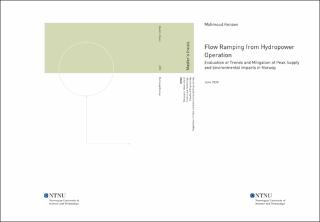| dc.description.abstract | Increased flexibility is vital in hydropower systems to meet future market demands, and
work is undertaken to improve hydropower machinery to handle larger ramping rates and
more frequent starts and stops. This increased flexibility simultaneously can cause rapid
changes in the flow rate known to be as flow ramping. The impacts of flow ramping on
downstream rivers due to hydropower operation are documented in several studies and
expected to increase in the future that it would require mitigation measures to provide
an environmentally friendly production regime.
This work aims for two main tasks. First, to put a grasp on the current level and characteristics of the flow ramping in Norway by analyzing the hourly turbine discharge data for
various hydropower plants using various hydrological indicators and tools used to quantify this impact and assessing the efficiency of the provided environmental legislation
and restrictions to eliminate this impact. Second, to evaluate this flow ramping impact
and mitigation measures in future production scenarios with the implementation of the
HydroFlex production scenario using hydraulic modeling on the river Nidelva in Norway.
Results show that the occurred flow ramping varies in terms of level and characteristics
depending on the type and operational pattern of the power plant itself. Additionally, the
provided measures and environmental legislation to restrict this ramping showed some
efficiency in reducing the magnitude of this ramping, yet; they did not cover all potentially
ecologically power plants. On the contrary, the intensity of flow ramping is expected to
increase severely due to the implementation of the HydroFlex production scenario, and
the provided traditional measures are not feasible solutions for mitigating this increased
impact in the investigated river Nidelva. It can be concluded that it is crucial to further
assess the efficiency of innovative technologies to coop with this increasing ramping
ratio. Lastly, using hydraulic modeling can be a very efficient tool for mapping out the
impact of flow ramping, and its recommended to use for further assessment of such
impact from different production scenarios. | |
